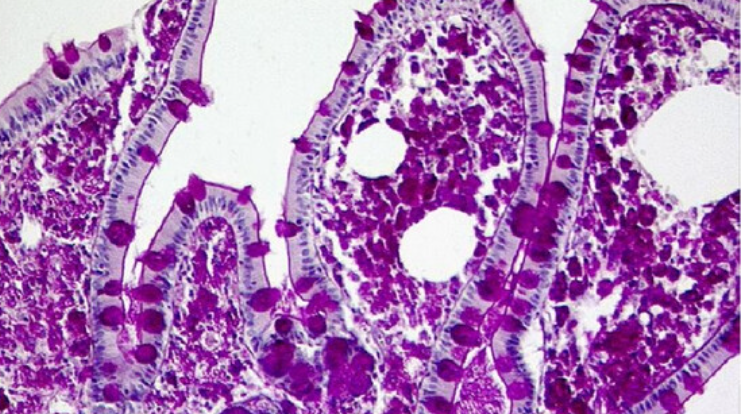
Tropheryma whipplei is a bacterium that causes Whipple’s disease, a rare and frequently misdiagnosed illness. Even though it is mostly linked to small intestinal malabsorption, its effects can extend to the joints, heart, brain, and skin, among other organs. The disease has a wide range of symptoms that frequently resemble those of other conditions, making diagnosis extremely difficult. Early detection is therefore essential because prompt treatment can have a significant positive impact.
Whipple’s disease symptoms usually start out as gastrointestinal distress and progress gradually. Usually, the first indications that something is wrong are diarrhea, weight loss, and abdominal pain. Malnutrition and a number of digestive problems result from the disease’s interference with the small intestine’s ability to absorb nutrients, especially fats. However, gastrointestinal symptoms are only the beginning. Large joints like the knees and ankles may experience migratory joint pain as a result of the disease, which frequently manifests months or even years before any digestive problems do.
Whipple’s Disease: Key Bio Information and Overview
| Aspect | Details |
|---|---|
| Cause | Tropheryma whipplei, a gram-positive bacterium |
| Symptoms | Diarrhea, abdominal pain, weight loss, joint pain, fatigue, neurological symptoms like memory loss |
| Diagnosis | Duodenal biopsy showing PAS-positive foamy macrophages, PCR testing for bacterial DNA |
| Treatment | Antibiotics (ceftriaxone, trimethoprim/sulfamethoxazole), extended courses, monitoring for relapse |
| Prevalence | Rare, approximately 1 in 1 million people, more common in middle-aged men (4:1 male-to-female ratio) |
| Prognosis | Good with early diagnosis and treatment; fatal if untreated |
| At-Risk Groups | Farmers, people with weakened immune systems, those working in soil exposure |

Reference: Mayo Clinic – Whipple’s Disease Overview
It is even more challenging to identify Whipple’s disease early on because the joint pain that patients experience is remarkably similar to that of other inflammatory diseases, such as rheumatoid arthritis. Remarkably, these symptoms frequently appear years before the more overt gastrointestinal symptoms. This delay in symptom development frequently results in a misdiagnosis for medical professionals who are not familiar with the disease, which can have disastrous outcomes.
Despite being less frequent, neurological involvement can be among the most worrisome features of Whipple’s disease. Memory loss, confusion, and more serious problems like dementia are among the cognitive difficulties that up to 40% of patients with the disease will eventually face. Actually, Tropheryma whipplei has been known to have an impact on the brain, causing symptoms that are frequently confused with those of other neurological conditions. The fact that the illness may go undiagnosed in its early stages, when the neurological symptoms are still mild, makes this even more difficult.
Treatment can result in significant improvements for most people with neurological symptoms. Early antibiotic treatment for Whipple’s disease usually eliminates the bacteria and greatly reduces many of its symptoms, including cognitive impairments. This isn’t a guarantee, though. In rare instances, the infection may return years after treatment, particularly if the prescribed course of action is not strictly adhered to.
Beyond the realm of medicine, Whipple’s disease has an impact on the larger community, particularly on those whose jobs are in agriculture. People who work with soil, especially farmers, are more likely to have Whipple’s disease. Questions concerning environmental factors and the reasons why some populations are more vulnerable to this infection are brought up by this connection. Despite being widely present in the environment, Tropheryma whipplei does not always cause illness. This brings up a crucial point: some people may be more susceptible than others due to underlying genetic factors or immune system deficiencies.
Even though Whipple’s disease is uncommon, those who have it may suffer significant consequences. After receiving a diagnosis and treatment, many patients go on to lead comparatively normal lives. Malnutrition, brain damage, and even death are among the potentially fatal consequences for those who remain undiagnosed or untreated. Thus, in order to guarantee the best possible outcome for patients, awareness and early diagnosis are essential.
The medical community is optimistic that future research will result in improved Whipple’s disease diagnostics and treatment alternatives. Given the disease’s rarity, it is simple for medical professionals to ignore it; however, as awareness grows, the likelihood of earlier detection and better results rises. Although the current long-term antibiotic treatment regimen works, it is obvious that more research is required to fully comprehend the disease’s scope and develop more effective ways to combat it.

